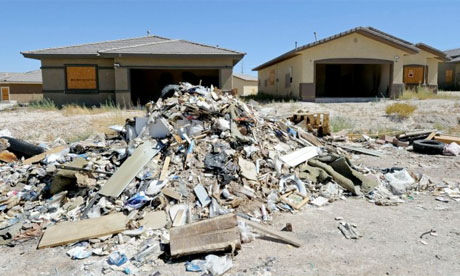 Tax credits disguised the fundamental weakness of the US housing market. The reality reveals bleak prospects for growth
Tax credits disguised the fundamental weakness of the US housing market. The reality reveals bleak prospects for growth

The howls of surprised economists were everywhere last week as the government reported on Tuesday that July had sharpest single-month plunge in existing home sales on record. The next day the commerce department reported that new home sales hit a post-war low in July.
All the economists who had told us that the housing market had stabilised and that prices would soon rebound looked really foolish, yet again. To understand how lost these professional error-makers really are, it is only necessary to know that the Mortgage Bankers Association (MBA) puts out data on mortgage applications every week. The MBA index plummeted beginning in May, immediately after the last day (30 April) for signing a house sale contract that qualified for the homebuyers' tax credit.
It typically takes 6-8 weeks between when a contract is signed and a house sale closes. The plunge in applications in May meant that homebuyers were not signing contracts to buy homes. This meant that sales would plummet in July. Economists with a clue were not surprised by the July plunge in home sales.
What should be clear is that the tax credits helped to pull housing demand forward. People who might have bought in the second half of 2010, or even 2011, instead bought their home before the tax credit expired. Now that the credit has expired, there is less demand than ever, leaving the market open for another plunge in prices. The support the tax credit gave to the housing market was only temporary.
It is worth asking what was accomplished by spending tens of billions of dollars to prop up the market for a bit over a year with these tax credits. First, this allowed millions of people to sell their home over this period at a higher price than would have otherwise been the case. The flip side is that more than 5 million people bought homes at prices that were still inflated by the bubble. Many of these buyers will see substantial loses when they resell their house.
The banks also had a stake in this. The homebuyers' tax credit prevented prices from declining as rapidly as would otherwise have been the case. This enabled millions of homeowners to sell their home at a price where they could pay off their mortgage. This made banks who could have been holding underwater mortgages very happy.
Of course, someone had to issue the mortgage to all those people who bought homes at prices that are still inflated by the bubble. The overwhelming majority of the mortgages issued in the last year and a half are insured by the government, either through Fannie Mae and Freddie Mac, or through Hud. So, taxpayers, not banks or private investors, are carrying the risk that further price declines will push these mortgages underwater.
The further plunge in house prices will have serious implications for the course of the recovery. By my calculations, the decline in house prices through the first half of 2009 eliminated $5-6tn of the $8tn of housing equity created by the bubble. Look to the further declines in the rest of this year to eliminate most or all of the remaining bubble equity.
The loss of this wealth will further dampen growth. This should drive home the fact that house prices, like the Nasdaq following the tech crash of 2000-2002, are not coming back. Homeowners will have to come to grips with this massive loss of wealth. While many commentators (no doubt, the surprised ones) complain that consumption is low, the reality is that consumption is still at an unusually high level relative to disposable income.
Furthermore, with a huge cohort of babyboomers approaching retirement with almost no wealth, there will be more need to save than ever. This need to save is accentuated by the plans of those in the Obama administration and the congressional leadership to cut social security.
This means that we should expect consumption spending to weaken sharply in the second half of 2010 and into 2011, as the savings rate rises into the 8-10% range, further slowing economic growth. This comes against a backdrop where final demand had only been growing at a 1.2% average rate over the last four quarters.
Final demand is GDP, excluding inventories. Growth was boosted over the last year by the restocking of inventories. This process is largely completed, which means that we should expect GDP growth to be pretty much equal to final demand growth going forward.
Starting with a 1.2% growth rate, then throwing in weaker consumption due to further house price declines, state and local government cutbacks, and the winding down of stimulus, it is questionable whether growth will even remain positive over the next four quarters. Given all these negative factors, it is very hard to construct a story showing the economy on a healthy growth path, even though many economists still seem to think it is. Of course, these economists were probably surprised by last month's home sales data.
(from guardian.co.uk,, 31, 2010)



No comments:
Post a Comment